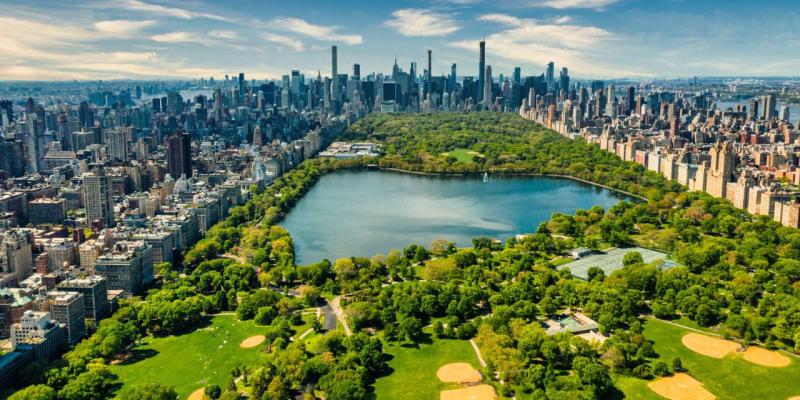Frederick Law Olmsted's Triumph
By: Laurie Olin (WSJ)


The bicentennial of Frederick Law Olmsted’s birth this year stimulates thought about the life and achievements of this great American. While it is difficult, some would say questionable, to compare works of art in different media—paintings with symphonies, sculpture with poetry, buildings with gardens—there are moments when a work of art in one medium trumps all the others, leaving the world, culture and life different thereafter. Examples range from Michelangelo’s Sistine Chapel to Picasso’s “Les Demoiselles d’Avignon.”
Designed by Frederick Law Olmsted and Calvert Vaux just before the Civil War in response to a competition for a new public park in Manhattan, Central Park was the first such park in America, and was their first collaboration. Olmsted and Vaux went on to design dozens of other successful parks and entire park systems such as in Buffalo that were beautiful, like Prospect Park, but none were as revolutionary. It changed the city, initiated the profession of landscape architecture in America, and inspired the invention and construction of parks throughout the country.
Olmsted was an intellectual and managerial genius; for a time an editor and publisher (of Thoreau, Melville and others in Putnam’s Monthly Magazine); a writer, abolitionist and correspondent who documented conditions throughout the South for the New York Daily Times (predecessor to the current New York Times). Those pieces were subsequently published in several volumes. In addition, he’d sailed before the mast to China and back and farmed in Connecticut and on Staten Island.
Parks have existed since Babylonian times, but consistently were the exclusive realm of a privileged few: kings, popes, czars, powerful landowners and financiers. Since the 17th century, however, private squares and parks were created to enhance the value and desirability of urban real-estate enterprises in France and England. Following revolutions at the end of the 18th century, some were thrown open to a broader public. Olmsted and Vaux were cognizant of these, as well as of a recent publicly funded one in Merseyside, England. The park they envisioned, however, was far more ambitious in scope and purpose, a triumph of invention and design, construction, social philosophy and landscape art.
If one could have gone into the neighborhoods of Manhattan in 1857 with a questionnaire to inquire what the citizens needed or desired, as one might today, one could never have come up with the program and agenda Olmsted developed. It was to be rus in urbe—the country brought into the city. Olmsted foresaw the scale of future growth and population of the city. He also believed that fresh air and nature—trees, water, greensward and sky—were health giving and that a park could contribute enormously to the well-being of the working class that constituted the bulk of the city. One must envision the waterfront bristling with the masts of ships. The chaotic, narrow, dirty and dangerous streets full of horses, mules, wagons and manure. Smoke belching from factories, kitchens and burning trash. People jammed into tenements amid noise and illness.
The plan this duo developed separated vehicles and horses from pedestrians and direct crosstown traffic from miles of circumambulatory carriage drives, bridle trails, paths and walkways. It provided amplitude and a complex assemblage of landscape spaces and types—open meadows, shady tree-lined promenades, wooded hills, and ravines, boating ponds, streams, picnic groves, pavilions and overlooks. Whereas paintings by Claude Lorrain and John Constable or Olmsted’s contemporaries Frederick Edwin Church and Albert Bierstadt presented images of pastoral, rural and wilderness landscapes to look at, Olmsted with Vaux’s drawings and watercolors produced visions a person could physically enter and spend the afternoon with family and friends. Their invention and artistry purposefully encouraged different social classes to be together in an environment of pleasure and delight. It was shared, open and democratic. It was generous, and aesthetically superb, a work of art that engendered community. (Ironically, this eventual gift to all of New York’s citizens from an outspoken abolitionist was accomplished through eminent domain and the removal of farms, homes and Seneca Village, a community of African-American landowners.)
Rilke famously pronounced that the demand art makes is to change one’s life. Another requirement of art is to transcend utility and convey a surplus of sensual or intellectual content—ideally both. Central Park certainly meets these requirements and then some. I can’t think of a single painting or building, poem or sculpture, song or symphony made by anyone in the history of the U.S. that tops Central Park as a greater, more seminal, work of art.
Mr. Olin was the landscape architect for Bryant Park, Columbus Circle, and the Getty Center




What a gift these two men left to future generations!
It should be noted that Olmstead left a bit of that to the city of Boston as well.
I believe that he had a part in the design of the Seattle parks and Arboretum, also. My girlfriend in a past life was a perpetual student, and one of her majors was landscape design, so every time we went for a walk I got a lesson on features and aesthetics.